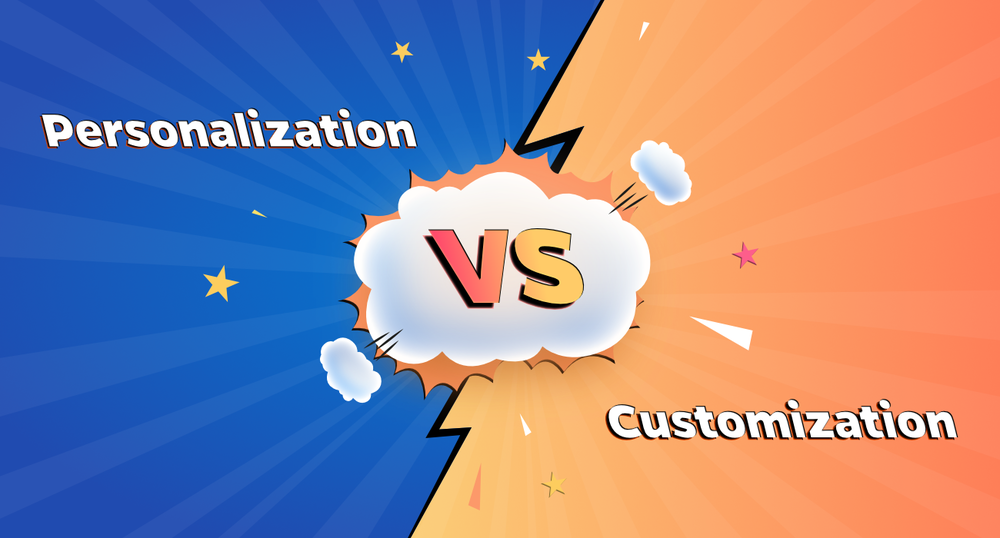
Click the play button above to listen to the blog.
Businesses are always looking for ways to grab the customer’s attention, especially in an era of digital information overload. This need to satisfy customers has given rise to new approaches that aim to improve the customers’ experience: personalization vs customization.
But do they actually mean the same thing? Or are they two entirely different concepts that need to be treated separately?
Let’s take a look at how these two terms differ from each other and how to use them properly:
The difference between personalization and customization depends on who is inputting the data or making the changes. Personalization is the action of creating or modifying an item using customer data to meet an individual’s needs. Customization is when the customer manually makes changes to the item to meet their needs or requirements.
Related: Is Hyper Personalization the Next Big Thing in Business?
Although seemingly similar at surface level, one particularly important difference to note here is that of implicit and explicit focus. Implicit means implied, so a company can modify the item without the customer expressing they want a change made. Explicit means something that is stated directly by the customer, such as a change to their item.
Personalization is implicit: takes place without actively asking users for their preferences. In other words, the company (or more likely their data and algorithm) controls and modifies the experience on the user’s behalf.
Customization is explicit: controlled by the user themselves and therefore explicit. Users are actively asked to make choices to tailor the experience to their own preferences.
Although both approach the end-user from different angles, you can combine them together into your customer engagement strategy to create a satisfied customer.
Digital technology has helped to stretch the limits of what personalization can do. Despite issues around the transparency of data used, 83 percent of consumers are willing to share their data to create a more personalized experience.
And, with more agile tech and sophisticated manufacturing techniques, customization has become far more accessible too.
Here’s how businesses implement personalization:
Here’s how businesses offer customization:
You don’t have to search far to find companies trying their hand at customization or personalization. But to find them doing it well, you need to dig a little deeper.
Here are a few examples of businesses that have boosted customer experience by nailing their personalization and customization tactics.
Spotify has a formidable reputation for their personalization game. Their personalized curated song lists have been a big hit with their users. The users’ home page contains sections based on their recent listening or more content you’d like.
This makes Spotify feel like the customers’ personal music streaming service, even though it’s been downloaded by millions of others. This personalized feature not only improves the user experience, but it opens up the discovery of new content that is relevant to them.
Nike are a long-established heavy hitter in the world of retailers, and have also made big waves with their flagship experience store. They took mass customization to the next level with NikeID, offering consumers the chance to customize products and make them unique..
Although the price goes up significantly compared to the standard versions of the sneakers, the customer’s get a chance to create a pair exactly how they want. This feature is highly used and a staple within the Nike brand by simply allowing customers to change what they want about an existing product.
The last thing that modern customers want is to feel like a dollar sign. So whatever type of business you’re in, providing personalization or customization enhances the customer experience.
Not only will your customers see that you really do care, but you’ll reap the benefits in revenue and loyalty as well.
Do you prefer personalization or customization? Or maybe you do both. Either way let us know in the comments section below.
Also, give this a share on social media so others can understand the differences between personalization vs customization.
The difference between personalization and customization depends on who is inputting the data or making the changes. Personalization is the action of creating or modifying an item using customer data to meet an individual’s needs. Customization is when the customer manually makes changes to the item to meet their needs or requirements.
This post was published on August 26, 2021
With ever-evolving customer expectations, it can be challenging for businesses to differentiate themselves from the…
Email marketing has been the tried and true way to connect with customers for years.…
Customers are empowered with more access to information, businesses, and options than ever before. Because…
Today’s technology helps customers stay connected with businesses more than ever before. But with so…
Customer self-service is the DIY of customer support. Just like many people choose the “do-it-yourself”…
Improving customer satisfaction is a primary focus for many companies. And with good reason. It…